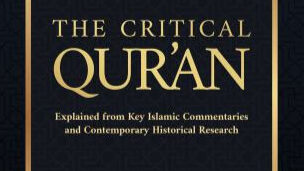
13 Mar Book Review by Mark Durie: The Critical Qur’an: Explained from Key Islamic Commentaries and Contemporary Historical Research
by Robert Spencer. New York: Bombardier Books, 2021. 548 pp. $45. Published in the Middle East Quarterly, Spring 2023.
The Qur’an is not an easy read, even in translation: its chapters are out of order, and its contents often obscure; verses do not follow logically one upon another, and some contradict each other. Additionally, while Muhammad’s biography provides the context for understanding particular passages, the Qur’an does not provide that information. Many English translations use antiquated King-James-style language, and translators typically translate what commentators think the text means, not what the text actually says.
For English readers, things improved in 2013 with the publication of Arthur J. Droge’s The Qur’an: A New Annotated Translation.[1] There is also a scholarly 2020 English commentary by Gordon D. Nickel, which uses Droge’s text.[2] To these resources has now been added Spencer’s The Critical Qur’an, “critical” in the sense that it exposes the reader to the opinions of Muslim commentators, medieval and modern.
Spencer, director of Jihad Watch and a fellow at the David Horowitz Freedom Center, does not spare the reader problematic passages, as his discussion of the wife-beating verse, Sura 4:34, exemplifies. Spencer also draws readers’ attention to internal contradictions in the text and to manuscript variants.
The Critical Qur’an has some limitations. Page headers do not provide sura (verse) numbers. The index is patchy: for example, “idolater” and “associate” are not to be found. A glossary would help. The lack of paragraphs in the Qur’anic text makes it hard to follow. Some scholarship, such as relying on Richard Bell’s idiosyncratic work from the 1930s,[3] is not up to date.
The extent to which Spencer bases his version on the work of others (something he acknowledges in the introduction) sometimes leads him to present commentary as translation. For example, in Sura 9:29, the Arabic literally says that conquered “people of the book” should pay tribute “out of hand.” This Spencer renders by adopting Yusuf Ali’s “with willing submission.”[4] Another example is Sura 7:26 where the Arabic says that God gave Adam and Eve “feathers.” Spencer translates this—relying on Muhammad Marmaduke Pickthall’s “splendid vesture”—as “beautiful garments.”[5]
That said, The Critical Qur’an is a unique and handy tool to read the Qur’an through the eyes of Muslim commentators, many available online, and supplemented by Droge’s excellent translation.
First published in the Middle East Quarterly.
[1] Sheffield, U.K.: Equinox, 2013.
[2] The Quran with Christian Commentary: A Guide to Understanding the Scripture of Islam (Grand Rapids: Zondervan Academic, 2020).
[3] The Qur’an. Translated, with a critical re-arrangement of the Surahs, 2 vols. (Edinburgh: Edinburgh University Press, 1937).
[4] The Holy Qur’an: Translation by A. Yusuf Ali (Lahore, Pak., 1938).
[5] The Meaning of the Glorious Koran: An Explanatory Translation (New York: A. A. Knopf, 1930).


No Comments